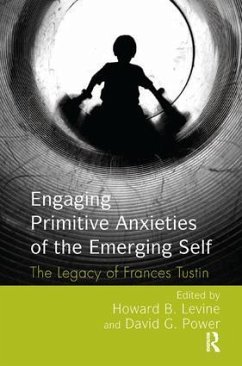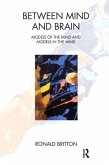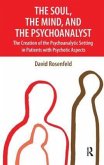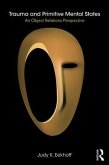Engaging Primitive Anxieties of the Emerging Self
The Legacy of Frances Tustin
Herausgegeben:Levine, Howard B.; Power, David G.
Engaging Primitive Anxieties of the Emerging Self
The Legacy of Frances Tustin
Herausgegeben:Levine, Howard B.; Power, David G.
- Broschiertes Buch
- Merkliste
- Auf die Merkliste
- Bewerten Bewerten
- Teilen
- Produkt teilen
- Produkterinnerung
- Produkterinnerung
This book, based on the 7th International Conference on the Work of Frances Tustin in 2014, offers readers a contribution to the understanding and treatment of primitive mental states and primitive character disorders.
Andere Kunden interessierten sich auch für
![The Protective Shell in Children and Adults The Protective Shell in Children and Adults]() Frances TustinThe Protective Shell in Children and Adults45,99 €
Frances TustinThe Protective Shell in Children and Adults45,99 €![The Primitive Edge of Experience The Primitive Edge of Experience]() Thomas OgdenThe Primitive Edge of Experience45,99 €
Thomas OgdenThe Primitive Edge of Experience45,99 €![Autistic Barriers in Neurotic Patients Autistic Barriers in Neurotic Patients]() Frances TustinAutistic Barriers in Neurotic Patients43,99 €
Frances TustinAutistic Barriers in Neurotic Patients43,99 €![Between Mind and Brain Between Mind and Brain]() Ronald BrittonBetween Mind and Brain28,99 €
Ronald BrittonBetween Mind and Brain28,99 €![The Soul, the Mind, and the Psychoanalyst The Soul, the Mind, and the Psychoanalyst]() David RosenfeldThe Soul, the Mind, and the Psychoanalyst39,99 €
David RosenfeldThe Soul, the Mind, and the Psychoanalyst39,99 €![Trauma and Primitive Mental States Trauma and Primitive Mental States]() Judy K. EekhoffTrauma and Primitive Mental States39,99 €
Judy K. EekhoffTrauma and Primitive Mental States39,99 €![Understanding Autistic Relationships Across the Lifespan Understanding Autistic Relationships Across the Lifespan]() Felicity SedgewickUnderstanding Autistic Relationships Across the Lifespan36,99 €
Felicity SedgewickUnderstanding Autistic Relationships Across the Lifespan36,99 €-
-
-
This book, based on the 7th International Conference on the Work of Frances Tustin in 2014, offers readers a contribution to the understanding and treatment of primitive mental states and primitive character disorders.
Produktdetails
- Produktdetails
- Verlag: Routledge / Taylor & Francis
- Seitenzahl: 302
- Erscheinungstermin: 15. Mai 2017
- Englisch
- Abmessung: 229mm x 152mm x 16mm
- Gewicht: 560g
- ISBN-13: 9781782202974
- ISBN-10: 1782202978
- Artikelnr.: 46483416
- Herstellerkennzeichnung
- Libri GmbH
- Europaallee 1
- 36244 Bad Hersfeld
- gpsr@libri.de
- Verlag: Routledge / Taylor & Francis
- Seitenzahl: 302
- Erscheinungstermin: 15. Mai 2017
- Englisch
- Abmessung: 229mm x 152mm x 16mm
- Gewicht: 560g
- ISBN-13: 9781782202974
- ISBN-10: 1782202978
- Artikelnr.: 46483416
- Herstellerkennzeichnung
- Libri GmbH
- Europaallee 1
- 36244 Bad Hersfeld
- gpsr@libri.de
B. Levine, Howard
Introduction -- Finding a center of gravity via proximity with the analyst -- Daydreaming and hypochondria: when daydreaming goes wrong and hypochondria becomes an autistic retreat -- "Black holes" and "fear of breakdown" in the analysis of a fetishistic-masochistic patient -- Autistic states in patients with a narcissistic structure -- Sensual experience, defensive second skin, and the eclipse of the body: some thoughts on Tustin and Ferrari -- "Emotional" storms in autistoid dynamics -- "The very same is lost": in pursuit of mental coverage when emerging from autistic states -- Bion and the unintegrated states: falling, dissolving, and spilling -- Inhibition of curiosity due to concern about the object's response: difficulties in tolerating a "third position" in relation to autism -- Language used as an autistic object -- The struggle to make the autistic child human -- Beckett's Endgame: the collapse of mental life -- The autistic object, ethology, and neuroscience: a way to a Copernican revolution in the understanding of autistic spectrum disorders (ASD)?
Introduction -- Finding a center of gravity via proximity with the analyst -- Daydreaming and hypochondria: when daydreaming goes wrong and hypochondria becomes an autistic retreat -- "Black holes" and "fear of breakdown" in the analysis of a fetishistic-masochistic patient -- Autistic states in patients with a narcissistic structure -- Sensual experience, defensive second skin, and the eclipse of the body: some thoughts on Tustin and Ferrari -- "Emotional" storms in autistoid dynamics -- "The very same is lost": in pursuit of mental coverage when emerging from autistic states -- Bion and the unintegrated states: falling, dissolving, and spilling -- Inhibition of curiosity due to concern about the object's response: difficulties in tolerating a "third position" in relation to autism -- Language used as an autistic object -- The struggle to make the autistic child human -- Beckett's Endgame: the collapse of mental life -- The autistic object, ethology, and neuroscience: a way to a Copernican revolution in the understanding of autistic spectrum disorders (ASD)?









